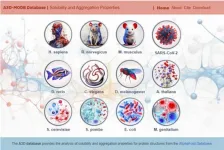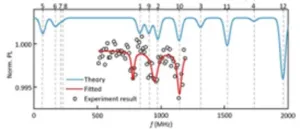(Press-News.org) COLUMBUS, Ohio – A species of exotic tick arrived in Ohio in 2021 in such huge numbers that their feeding frenzy on a southeastern farm left three cattle dead of what researchers believe was severe blood loss.
The scientists from The Ohio State University have reported in the Journal of Medical Entomology on the state’s first known established population of Asian longhorned ticks, and are now conducting research focused on monitoring and managing these pests.
So far, these ticks are not deemed to be a threat to human health. They tend to favor large livestock and wildlife, such as cattle and deer. Just a handful of the hundred ticks from the farm screened for infectious agents tested positive for pathogens, including one, Anaplasma phagocytophilium, that can cause disease in animals and humans. Elsewhere this tick carries another pathogen, Theileria orientalis, that affects cattle, and cases of bovine theileriosis have been reported in Ohio.
Researchers say the tiny brown ticks – the size of a sesame seed in some life stages and pea-sized when engorged – are persistent, however: Surveillance showed they returned the following summer to the farm despite the application of pesticides in 2021.
“They are going to spread to pretty much every part of Ohio and they are going to be a long-term management problem. There is no getting rid of them,” said Risa Pesapane, senior author of the paper and an assistant professor of veterinary preventive medicine at Ohio State.
“The good news about the ticks, though, is that most tick control agents that we currently have seem to kill them. Still, managing them is not easy because of how numerous they are and how easily they can come back.”
Asian longhorned ticks originate from East Asia and were first detected in the United States in New Jersey in 2017. When Pesapane joined Ohio State in 2019 as a tick-borne disease ecologist, the ticks were reported in West Virginia – meaning it was only a matter of time before they crossed the river into Ohio, she said.
She found the first of these ticks in Ohio, on a stray dog in Gallia County in 2020, and another was collected from a cow in Jackson County in June 2021. And then a farmer from Monroe County called Ohio State later that summer to report three of his 18 cattle, heavily infested with ticks, had died.
“One of those was a healthy male bull, about 5 years old. Enormous. To have been taken down by exsanguination by ticks, you can imagine that was tens of thousands of ticks on one animal,” said Pesapane, who also has a faculty appointment in Ohio State’s School of Environment and Natural Resources.
Pesapane and colleagues collected almost 10,000 ticks within about 90 minutes on the farm, leading her to speculate that there were more than 1 million of them in the roughly 25-acre pasture.
Asian longhorned ticks’ secret colonization weapon is the ability to reproduce asexually, with each female laying up to 2,000 eggs at a time – and all 2,000 of those female offspring able to do the same.
“There are no other ticks in North America that do that. So they can just march on, with exponential growth, without any limitation of having to find a mate,” Pesapane said. “Where the habitat is ideal, and anecdotally it seems that unmowed pastures are an ideal location, there’s little stopping them from generating these huge numbers.”
Because of their ability to hide in vegetation, Asian longhorned ticks also can escape pesticides that kill only when coming into direct contact with a pest.
“It would be wisest to target them early in the season when adults become active, before they lay eggs, because then you would limit how many will hatch and reproduce in subsequent years. But for a variety of reasons, I tell people you cannot spray your way out of an Asian longhorned tick infestation – it will require an integrated approach,” Pesapane said.
She and colleagues are working as rapidly as they can at filling in knowledge gaps about these invaders and developing training materials and policy recommendations for affected industries. As one example, Pesapane said, tick inspections of livestock could provide a window for application of an antiparasitic agent to eliminate the risk of transporting the exotic arachnids across multiple state lines.
Ohioans are encouraged to help with research efforts: People who think they’ve spotted an Asian longhorned tick can email ticks@osu.edu for instructions on how to collect the specimen and send it to Ohio State scientists as part of ongoing surveillance. To date, the lab has received Asian longhorned ticks from residents of 11 Ohio counties.
More information about spotting Asian longhorned ticks and preventing tick exposure is available on Ohio State’s Bite Site.
This work was supported by the U.S. Department of Agriculture. Co-authors on the study were Andreas Eleftheriou, Julia Beckett and Ningzhu Bai, all of Ohio State.
#
Contact: Risa Pesapane, Pesapane.1@osu.edu
Written by Emily Caldwell, Caldwell.151@osu.edu; 614-292-8152
END
By analyzing data from the Harvard Implicit Association Test—a widely accepted measure of a person’s attitudes toward people based on characteristics like race, gender, and sexuality—researchers find that healthcare professionals, and in particular nurses, are more biased against transgender people than are people who are not healthcare professionals. A questionnaire administered before and after the test shows that healthcare professionals are less likely to know transgender people personally and that nurses are more likely to conflate sex and gender identity. These results are reported November 3 in the journal Heliyon.
The Implicit Association Test works by asking participants ...
About The Study: The findings of this study of 414,000 respondents to the 2021 Behavioral Risk Factor Surveillance System survey suggest that e-cigarette use remained common during the COVID-19 pandemic, particularly among young adults ages 18 to 24 (18% prevalence). Notably, 71.5% of individuals ages 18 to 20 who reported current e-cigarette use had never used combustible cigarettes. These results underscore the rationale for the implementation and enforcement of public health policies tailored to young adults.
Authors: Michael J. Blaha, M.D., M.P.H., of the Johns Hopkins ...
A survey from Ann & Robert H. Lurie Children’s Hospital of Chicago found that 40 percent of parents who worked remotely during the pandemic reported higher parenting stress compared with only 27 percent of parents who worked onsite.
Results revealed a gender difference – fathers who worked from home were twice as likely to report that parenting was stressful all or most of the time compared to fathers who worked onsite. Parenting stress for mothers who worked at home was slightly higher, but it did not reach statistical significance.
The study found no differences ...
About The Study: In this study of a nationally representative sample of 7,062 non-Hispanic Black or white adults, health care spending for Black adults in the U.S. was equal to or less than that of white adults, but only in areas of racial and economic equity and equitable insurance access. The results underscore the continuing need to recognize place as a contributor to race-based differences in health care spending.
Authors: Lorraine T. Dean, Sc.D., of the Johns Hopkins Bloomberg School of Public Health in Baltimore, is the corresponding author.
To access the embargoed study: Visit our For The Media website at this link https://media.jamanetwork.com/
(doi:10.1001/jamahealthforum.2023.3798)
Editor’s ...
Findings revealed a gender difference
‘Might be a reflection of societal expectations that men should prioritize work obligations over family needs’
Study authors offer tips for parents, employers to mitigate stress of remote work
CHICAGO --- Forty percent of parents who worked remotely during the COVID-19 pandemic reported higher parenting stress compared with only 27 percent of parents who worked onsite, reports a new survey from scientists at Northwestern University and Ann & Robert H. Lurie Children’s Hospital ...
Researchers at the IBB-UAB have developed the most comprehensive database available to date to help understand the basis of protein aggregation, a phenomenon associated with ageing and several pathologies. The new resource, A3D-MOBD, brings together the proteomes of twelve of the most studied model organisms which cover distant biological clades and contains over half a million predictions of protein regions with a propensity to form aggregates.
The A3D-MOBD was developed by the Protein Folding and Computational Diseases Group at the Institut de Biotecnologia i de Biomedicina of the Universitat Autònoma de Barcelona (IBB-UAB), which is directed by Biochemistry and ...
Measuring the pH of substances gives us vital clues about the world around us, such as identifying contaminated water or checking the toxicity of medical or cosmetic products.
Often, only small amounts of samples are available, but monitoring the variation in pH in these miniscule volumes matters. For example, identifying pH changes within tiny volumes of fluid from single cells can help in the detection of ovarian cancer.
However, the current methods for measuring pH are mainly for bulk solutions and are not sensitive enough or are too fragile to measure small volumes on a commercial scale.
In a recent study published in Microchimica ...
Teams led by Prof. DU Jiangfeng, Prof. SHI Fazhan and Prof. KONG Fei from the University of Science and Technology of China (USTC) of the Chinese Academy of Sciences (CAS) used the Nitrogen-Vacancy (NV) center inside a single nanodiamond for quantum sensing to overcome the problem of random particle rotation.
The study was published on Oct. 7th in Nature Communications.
It is an important goal to detect and analyze molecules under physiological in situ conditions in the field of life sciences. Only by observing biomolecules under this condition can we reveal conformation changes when they realize physiological functions.
Thanks to its high sensitivity, good biocompatibility, and ...
A new study from Carnegie Mellon University, Bayes Business School (formerly Cass), and Bocconi University has found that men are less eager and likely to share negative information than women, while there was little difference when it comes to positive news.
Published in the Journal of Experimental Social Psychology, the authors suggest that this may be due to a greater concern among men over how other people will see them, resulting in a tendency to self-promote by sharing positive information about themselves and not revealing their negative experiences to others.
Dr Erin Carbone, Visiting Assistant Professor in the Department of Social ...
A new publication from Opto-Electronic Science; DOI 10.29026/oes.2023.230025 discusses near-eye display based on metasurface devices.
With the rise of the meta-universe, virtual reality (VR) and augmented reality (AR) technologies have been developing rapidly in recent years. Near-eye displays are crucial technologies for VR and AR. Despite the rapid advances in near-eye display technologies, there are still challenges such as large field of view (FOV), high resolution, high image quality, natural free 3D effect, and compact form factor. Great efforts have been devoted to striking a balance between visual performance and device compactness. ...




